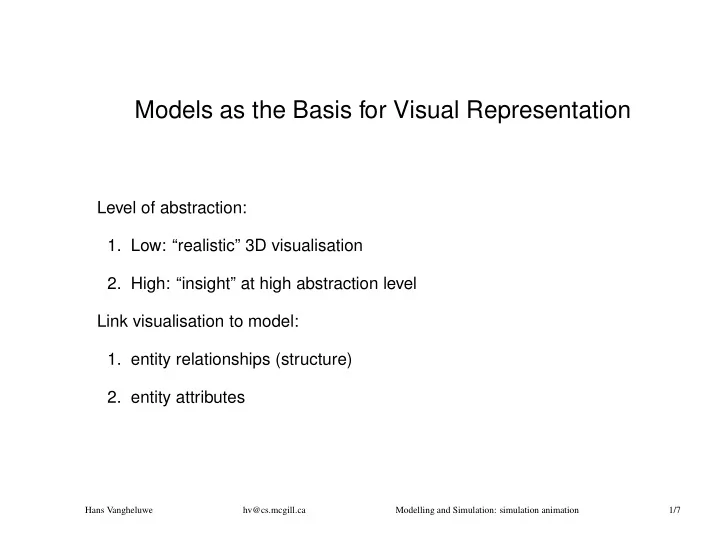

Models as the Basis for Visual Representation Level of abstraction: 1. Low: “realistic” 3D visualisation 2. High: “insight” at high abstraction level Link visualisation to model: 1. entity relationships (structure) 2. entity attributes Hans Vangheluwe hv@cs.mcgill.ca Modelling and Simulation: simulation animation 1/7
� � � � � � Categories of Simulation Animation Implementation 1. Animation using a post-processor 2. Direct simulation animation integrated program (one thread) cooperating programs (multiple threads, observer pattern) 3. Visual Interactive Simulation: user in the loop interrupt, modify (parameters, IC, . . . ), re-start discrete event: transient behaviour discrete event: statistical relevance ? need to keep track of modifications (generate script logging the modifications) Hans Vangheluwe hv@cs.mcgill.ca Modelling and Simulation: simulation animation 2/7
� ✁ � ✁ Technical Problems of Simulation Animation Transformation of simulated time to wall-clock time: non-equidistant, speedup/slowdown use buffer Suspension of animation on multi-tasking systems pre-compute (only if no real-time input) Hans Vangheluwe hv@cs.mcgill.ca Modelling and Simulation: simulation animation 3/7
Real Time Simulation faster than Real Time virtual time Real Time "analytical" slower than Real Time wall clock time Hans Vangheluwe hv@cs.mcgill.ca Modelling and Simulation: simulation animation 4/7
✂ Specification 1. Simulation (event, possibly parametrized) trace 2. Graphical objects 3. Mapping table: event graphical object methods 4. Speedup Hans Vangheluwe hv@cs.mcgill.ca Modelling and Simulation: simulation animation 5/7
Cashier/Queue Animation Hans Vangheluwe hv@cs.mcgill.ca Modelling and Simulation: simulation animation 6/7
Real Time Deadlines: Rate Monotonic Scheduling (RMS) Real Time Deadlines t simulation Hans Vangheluwe hv@cs.mcgill.ca Modelling and Simulation: simulation animation 7/7
Recommend
More recommend